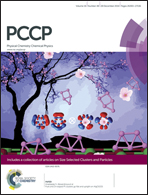Design and photovoltaic characterization of dithieno[3,2-b:2′,3′-d]silole copolymers with positioning phenyl groups†
Abstract
A two-dimensional (2D) low bandgap polymer (PDTS-Ph-TTz) based on dithieno[3,2-b:2′,3′-d]silole (DTS) with phenyl substitution on the bridging silicon atom and thiazolo[5,4-d]thiazole (TTz) was designed and synthesized for photovoltaic applications. The impact of conjugated side chains on the optical, electrochemical and energy levels of the polymer was studied. The phenyl substituted DTS polymer exhibited a 0.16 eV down-shifted highest occupied molecular orbital (HOMO) energy level and ca. 0.1 eV narrowed bandgap in comparison to the corresponding polymers with alkyl substitution on the silicon bridge. The influence of the blend weight ratio, the PFN layer, mixed solvent, THF exposure and polar solvent treatment and thermal annealing on the performance of PDTS-Ph-TTz:PC71BM devices was studied. PDTS-Ph-TTz : PC71BM (1 : 1, weight ratio) devices delivered the highest power conversion efficiency of 2.14% by using the PFN layer and THF annealing. Thermal annealing was found to exert a negative effect on the device performance. The morphology evolution of blend films processed with different solvents explained the difference in device performance. The results indicate that phenyl substitution is an effective way to tune the HOMO and bandgap of polymer donors for enhanced photovoltaic performance with the as-demonstrated 2D-conjugated DTS structure.
![Graphical abstract: Design and photovoltaic characterization of dithieno[3,2-b:2′,3′-d]silole copolymers with positioning phenyl groups](/en/Image/Get?imageInfo.ImageType=GA&imageInfo.ImageIdentifier.ManuscriptID=C4CP04621H&imageInfo.ImageIdentifier.Year=2014)

 Please wait while we load your content...
Please wait while we load your content...